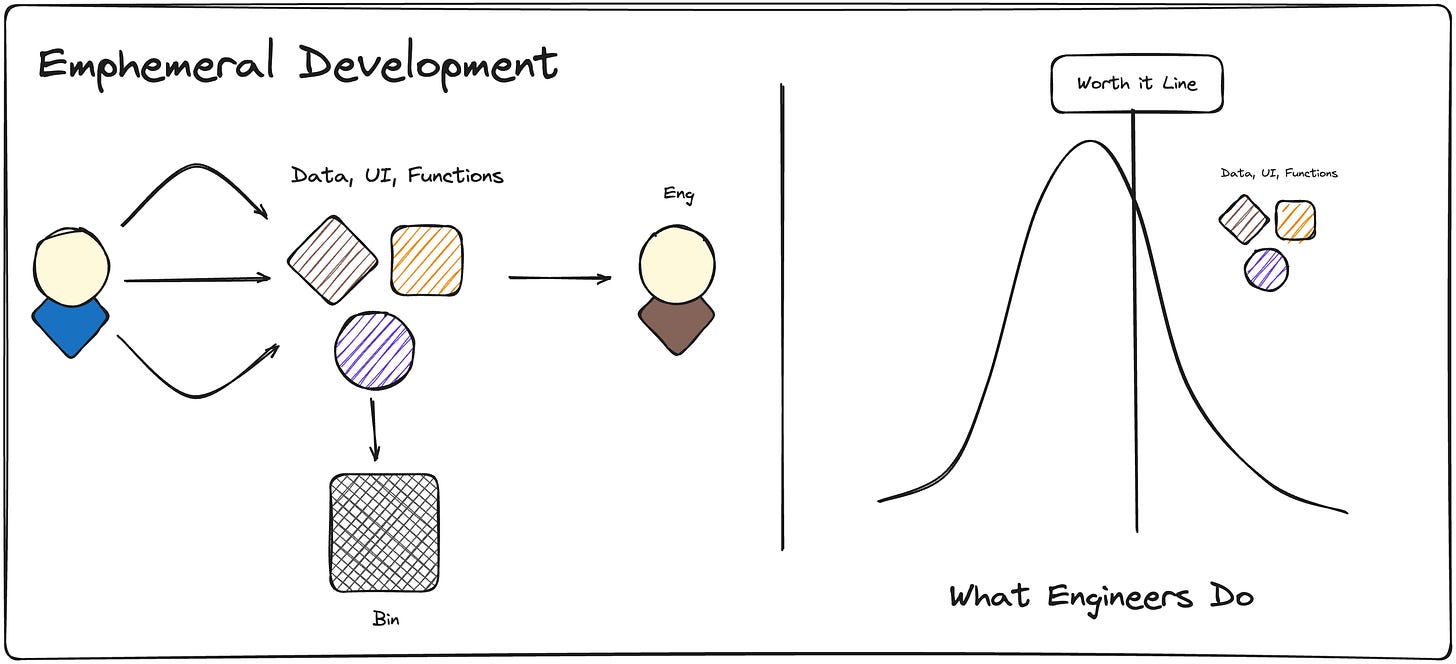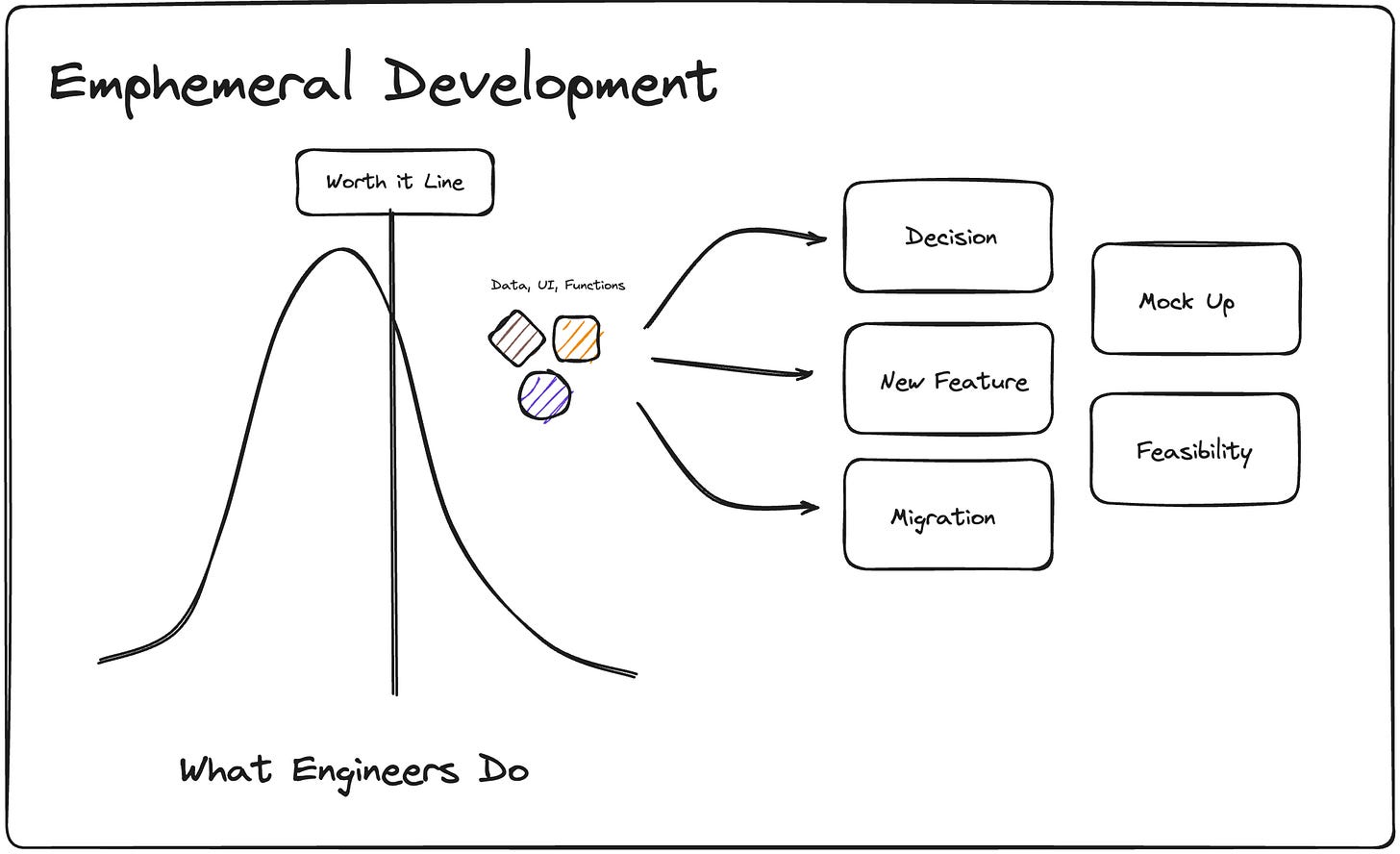Ephemeral Software: UI, Data, and Functions in an AI-First World
What's "worth it" for Engineering to work on now
Ephemeral software is software that exists briefly, long enough to solve a specific, immediate problem, then it gracefully disappears. Unlike traditional software built for persistence and longevity, ephemeral software is temporary by design. IE, rm -rf /whatever-dir-i-did-it-in. UI that is useful for a day or a week.
Functions that transform data to find an outcome and then are thrown away. Temporary datasets which are compilations from systems of record which collapse towards a decision and then are thrown away. All of these exist just-in-time for when they are needed, then fade away.
Why This Matters Now
Every engineering team knows the pain of maintaining dashboards nobody looks at, codebases swollen with unused features, or costly software subscriptions barely utilized. In many cases, the represent business problem statements that are no longer valid.
I'm seeing a slow change in the way I work. This isn't the autocomplete of Copilot or Cursor, nor the fully written vibe coding experience. It's something in between. Tightly focused on a specific goal and only looking for the output at the end. If it's important, it sticks but never with the intention of doing so.
I do cheap up front work first that I throw away by default. After I'm done with it, I ask myself whether its useful enough to keep around or cheaper to regenerate with new context. If it isn't worth explaining to a colleague or committing, I throw it away.
I'll talk more about this later, but essentially with the expectation that I will bin the work I'm doing from the outset, I can capture the long tail value of what Engineers could work on. The stuff that's now worth it to do.
Several forces make this paradigm shift inevitable:
AI Capability: Code generation quality has crossed the utility threshold
Complexity Crisis: Traditional software and SaaS never quite hits the needs that I have (not close to worth it)
Speed Requirements: Decisions are often needed faster than these tools can provide
I believe I'm starting to see the emergence of a new approach to development. The effect comes from the likes of Cursor, Windsurf and Claude Code among many other players but not in the way most developers use them.
The Ephemeral Paradigm
Traditional software development assumes permanence. It's because often the most costly part of software is the development time. Because of this we want to be as right the first time as possible and to steer developers to projects that have economic value. We build applications expecting them to live for a long time because of this cost. But what about the hobby project? What about the proof of concept that you're "just not sure" whether you're capable of doing? What if you need to figure out whether anyone can do it?
Real software, whatever that means, then gravitates to projects that have weight to them. Ones that are permanent with your data, your compute and the assumption it will move to production. That assumption that the cost to implement the idea is the main cost has changed. What's worth it is now different.
Just-In-Time Software Development
This paradigm borrows heavily from manufacturing's just-in-time methodology:
No Inventory: Don't build software until you need it
Reduced Waste: No over-engineered solutions gathering dust
Quality Focus: Each ephemeral solution serves a specific, well-defined purpose
Rapid Response: Generate solutions as needs arise, not in anticipation
When you need a dashboard, spin one up. When the need passes, let it disappear. Need to compute an answer for a specific problem. It doesn't have to stick around if you're working on problems are directional. The valuable data and insights don't need to live longer than they're useful for.
Capturing fat tail value
With the expectation that I will bin some of the work I'm doing, I can capture the long tail value of what Engineers could work on. The stuff that's now worth it to do.
The traditional "worth it line" has kept us from solving thousands of small problems. Every engineering team has a backlog of ideas that never make the cut: the one-off analysis that would save an hour a week, the custom dashboard for that quarterly review, the data transformation script that would make life easier but isn't critical enough to prioritize.
These tasks live in the fat tail of the distribution. Individually, they're not worth the investment of traditional development. But collectively, they represent enormous unrealized value.
What lives in the fat tail:
Quick feasibility studies that inform better decisions
Temporary dashboards for specific investigations
One-time data migrations or transformations
Proof-of-concepts that test assumptions
Custom visualizations for a single presentation
Ad-hoc analysis tools that answer "what if" questions
When the cost to create drops by 10x or 100x, the economics flip. Suddenly, building a custom tool to save two hours becomes worthwhile if it takes five minutes to generate. The accumulated value of solving hundreds of these micro-problems compounds into significant productivity gains.
Addressing uncertainty
I find most of these types of problems for me have a higher degree of uncertainty compared to what we typically think of as "worth it". I suppose its the stuff that flirts at the edge of what's possible with Engineering within the constraints of the business.
This isn't about building more software. It's about solving more problems. Each ephemeral solution has the potential to remove a small friction, answer a lingering question, or provide clarity where there was ambiguity. The value isn't in the code itself, but in the outcomes it enables: faster decisions, clearer insights, and smoother workflows.
The real magic happens when teams realize they can now say "yes" to problems they've been living with for years.
Looking Forward
Ephemeral software is already changing how I work. Instead of debating whether something is worth building, I just build it. If it's useful, great. If not, I delete it and move on or try again.
This approach works because the economics have changed. When you can generate a solution in minutes instead of days, different things become worth doing. The small improvements, the one-off analyses, the temporary tools, they all make sense now.
The interesting part is what happens when you stop being precious about code. You try more things. You solve more problems. You spend less time maintaining old solutions that no longer fit.
I think we'll see more of this. As AI tools improve, the cost of creation will keep dropping. The traditional line between "worth it" and "not worth it" will keep moving. More problems will become solvable.
For now, I'm finding value in embracing the temporary. Building what I need when I need it. Throwing away what I don't. It's a different way of working, but it's working.



